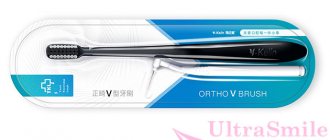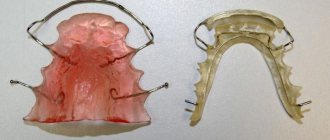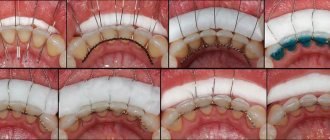This is a headache and a nightmare for any orthodontist: a patient who has had his braces removed and given a removable retainer and instructions for its use returns after some time with complaints about the curvature of his previously straight teeth. The retention period is the most psychologically difficult part of the treatment. Everything is already perfect, and then you have to wear a retainer. Yes, there are other reasons for the unsuccessful outcome of the correction. And although they are much less common, let’s talk about them in more detail.
When is it time to remove braces?
Typically, the duration of wearing braces depends on the severity of the pathology and the age of the patient. The more complex the clinical case and the older the person, the longer it takes to straighten the teeth. However, the first changes are noticeable within a few months after fixing the system. When it is clear that it is time to remove the braces, the doctor will inform you about the expected end date of treatment.
The process of correcting the bite can take from several months to 2 years. An experienced and highly qualified orthodontist is able to select the most optimal correction scheme that allows you to achieve your goal in the shortest possible time. If you strictly follow all the instructions, the day when you need to remove your braces will not be long in coming.
Pros of lumineers
The procedure for restoring teeth using lumineers is more expensive. This is due to the fact that plates 0.2–0.3 mm wide are thinner than veneers, so their production while maintaining the same high performance properties is a more labor-intensive process. Lumineers are often used to hide pigmentation defects after treatment of caries in the spot stage. Indications for this method of dental restoration are other factors: erosion and damage to the enamel, the presence of cracks and chips, visible diastema (wide spaces between units), the presence of old and deteriorated fillings. Often, plates are considered as an alternative to braces, which is not inferior to well-known designs in terms of strength, and in appearance is completely ahead of them, allowing teenagers not to experience psychological discomfort. Among other obvious advantages of dental restoration using lumineers, the following factors are worth noting:
- minimal turning of elements is required;
- You can create a dazzling smile in 3 visits;
- the overlays do not require special care;
- the adhesive composition contains fluorine, which is beneficial for enamel;
- there is no need to use anesthesia;
- the materials do not cause allergies and take root well;
- the plates serve flawlessly for 15–20 years;
- the doctor can remove the structure at any time.
ON A NOTE! Making impressions in the laboratory takes from 5 to 10 days, depending on the complexity, configuration and volume. However, technologies are already emerging that make it possible to restore teeth using ultra-thin onlays in one visit to the doctor. Thus, miraculous prosthetics using the CAD/CAM system makes it possible to restore the former attractiveness of a smile in the shortest possible time.
How are braces removed from teeth?
Most patients know virtually nothing about how braces are removed. The procedure is simple and involves several manipulations. Before the doctor begins work, you can ask him how long it takes to remove braces. As a rule, regular clasps are removed in about twenty minutes, and a lingual system in just under an hour. Any orthodontist can remove braces, regardless of whether the person is his patient or not.
The process of removing braces involves several stages.
- Preparation.
A retractor is installed for the patient to protect the oral mucosa from damage. - Removal of the structure.
The ligatures and arches are removed first, then the braces themselves. - Grinding.
Remains of glue are removed from the teeth by polishing, and the enamel is coated with a remineralizing composition.
Does it hurt to remove braces? Definitely not. Dental procedures cause some discomfort, but the discomfort is quite minor and mainly depends on the individual pain threshold.
The result of dental prosthetics
Photos before and after prosthetics clearly show the scope of treatment performed. After prosthetics, tight contacts have been created between the teeth, and food is no longer clogged, a balance in the work of the facial muscles has been achieved - facial expressions have become symmetrical, the patient really liked the appearance of the teeth - the natural beauty of the smile has been created.
To secure the position of the teeth (since only a year has passed since the orthodontic treatment, it is necessary to continue the retention period), on the recommendation of the myofunctional therapist, removable retention guards were made, which the patient will wear at night. During the day, nothing will prevent the tongue muscles from working correctly, thereby securing the achieved result.
Can I remove braces myself?
The query “How to remove braces at home?”
found on the Internet quite often. But it should be noted that without special skills and tools it is impossible to correctly remove the system. Removing the structure yourself can cause damage to the mucous membrane, teeth and gums. Even if you have theoretical knowledge of how to remove braces yourself, you should not do this, since the procedure is followed by the mandatory installation of a retainer, which you cannot purchase and secure yourself. In addition, at home it is also impossible to remove glue residues and polish the surface of the teeth.
Even one loose bracket cannot be removed without the help of a doctor without damaging the entire structure. It is necessary to make an appointment with an orthodontist as soon as possible to repair the system, since the absence of one element can disrupt its balance, and the effectiveness of treatment will decrease. Before going to a specialist, it is better to fix the fallen lock with medical wax, sold in a pharmacy.
Advantages of veneers
Indirect dental restoration using the installation of the thinnest plates is in demand today not only by public figures, but also by ordinary people who dream of eliminating imperfections of elements. Veneering involves grinding down 0.5–0.7 mm, after which plates of the selected shade made from individual impressions are glued onto the polished surface. Dental restoration using this method involves processing from 4 to 10 units in a row, that is, a plate is not placed on a separate element. There are some contraindications for the installation of such structures: grinding gums (bruxism), pathological inflammation of soft tissues, a high degree of abrasion of hard tissues on which it is impossible to attach elements. In addition, the installation of onlays is not recommended in the presence of dentures made of hard materials. Otherwise, indirect dental restoration has many advantages.
- The high aesthetic component of the procedure allows you to create a dazzling smile and hide imperfections.
- Sufficient mechanical strength of the plates, resistance to temperature changes, and the influence of food coloring.
- The tight fit of the plates protects the enamel from external influences, protects it from destruction, and prevents the penetration of bacteria.
- The ability to bind together disparate elements, reducing loosening that occurs with age.
- Elimination of yellowness, fluorosis, chips and microcracks resulting from damage and injury.
- The possibility of covering not only the front part, which preserves the taste sensitivity of the units, but also “dressing” the tooth on both sides to increase strength.
NEED TO KNOW! Veneers can be ceramic, composite or zirconium. The former are distinguished by a higher aesthetic component and increased whiteness. However, ceramics is a rather fragile material. Polymer-based composites are characterized by a less attractive appearance, but are more practical and quite affordable. Zirconium guarantees the longest life of the plates.
Teeth after removing braces
Usually, after removing braces, the condition of the teeth leaves much to be desired - glue residues, stains and cracks spoil the impression of the treatment result. White areas on the enamel after removing braces indicate a lack of microelements in the tooth tissues during the period of wearing the orthodontic apparatus.
There is no need to worry about aesthetic defects caused by wearing the system. After the braces are removed, the enamel is restored by applying a remineralizing composition, and irregularities are removed by polishing. In some cases, the installation of veneers is used or the method of artistic restoration is used in order to obtain ideal teeth from an aesthetic point of view.
Caring for removable devices
- After wearing it, clean it daily with a brush and paste,
- rinse with water at room temperature before use,
- Treat once a week with special tablets or solutions “for cleaning removable orthodontic appliances” according to the instructions,
- store in a clean container,
- try not to lose the device, protect it from mechanical deformation.
It is important to know: the retainer must be on both the upper and lower jaw. The absence of retainers is unacceptable - the teeth may return to their original position.
What do you do after removing braces?
The treatment process does not end with getting rid of the orthodontic structure. The doctor will perform several procedures to restore your teeth to their natural color and attractive appearance.
With the help of professional hygienic cleaning after removing braces, the remaining glue, plaque and tartar that have accumulated under the clasps while wearing the device are removed from the tooth surface. Remineralizing therapy and fluoridation saturate the enamel weakened by constant stress with the necessary substances.
After removing braces, teeth whitening is recommended no earlier than a month later, when the condition of the dental tissues improves. Premature lightening threatens increased sensitivity and prolonged pain.
Removing braces: how to remove the orthodontic structure
Where can braces be removed and how will the procedure take place? These questions concern many people undergoing orthodontic treatment or just preparing to wear braces. Many people think that it is painful or unpleasant, or mistakenly assume that they can remove braces themselves, at home. In fact, it is impossible to remove braces without visiting an orthodontist’s office. This is a simple and non-painful procedure, so there is no need to be afraid of it. To remove braces from your teeth, the doctor will not have to perform any complicated actions; the removal process will go through quite quickly. Lingual braces are removed within an hour, conventional vestibular braces are removed even faster - in 20-30 minutes.
How does the process work? We will describe to you the procedure for removing braces from your teeth in detail. So, to remove your braces, you will go to the orthodontist, and the doctor will do the following:
- Install a retractor in the oral cavity, which will protect the soft tissues of the mouth and mucous membranes during removal of braces;
- Remove the braces system. To remove the structure, the orthodontist will first remove the arches and ligatures, and then the braces themselves.
But simply removing the braces is not enough - after removing the orthodontic structure, be sure to remove any remaining adhesive from the dental surfaces, grind and polish the tooth enamel, and then treat it with a special remineralizing compound.
What do you wear after braces are removed?
Without the pressure of the orthodontic system, the teeth will try to return to their original position if not prevented. To prevent the teeth from becoming crooked after the braces are removed, the patient is fitted with a special retainer that fixes the dental units in the desired position to secure the result. Such structures are divided into removable and non-removable.
- Fixed retainer.
A thin wire is glued to the inside of the teeth using a filling material. The arch is absolutely invisible when worn, does not affect diction and does not cause discomfort. - Removable retainer.
We are talking about a silicone mouthguard, which is made according to individual impressions of the patient’s jaws, or retention plates after removing braces, intended for use while sleeping.
The retention period exceeds the duration of treatment by at least 2 times. Some patients wear a retainer throughout their life.
Removable retention device in the form of a plate, mouth guard or two-jaw device
Mode of use (if there are no other instructions from the attending physician):
- first year - every day for 8 hours a day (during sleep),
- next 6 months - every other night,
- next six months – 2 times a week,
- after 2 years – once a week for control.
Control: when installing a retainer, there should be no noticeable pressure on the teeth. If it appears, it means that the teeth have shifted slightly. In this case, it is necessary to leave the retainer overnight and re-check it after 1 week.
Feelings after removing braces
Few people like the way their teeth look after braces are removed. However, aesthetic defects can be easily eliminated. A more serious problem is physical discomfort. After removing braces, teeth hurt from trying to return to their previous position, especially after installing a retainer, which blocks any movement. In addition, weakened and sensitive enamel reacts sharply to temperature changes, which also causes discomfort. Dizziness or nausea after having braces removed may be related to retainers. If such symptoms occur, be sure to consult a specialist.
Video about how to remove braces from teeth
What methods are used to correct the dentition after braces?
- Due to the inability to carry out hygienic cleaning while wearing braces, teeth can noticeably change color. Teeth whitening after braces can help get rid of unpleasant yellowish or gray tints and dark spots.
- If everything is in order with the functionality of the teeth, then indirect and direct methods can be used to restore their aesthetics.
- The quickest way is to restore a tooth using the direct method - by correcting the shape of the dental crown by layer-by-layer application of photopolymer materials of carefully selected shades. Photopolymers are most often used to correct the uneven cutting edge of the central incisors.
- Indirect ones will require several visits to the doctor. The shape of the tooth will be corrected using an individual microprosthesis made from an impression - a veneer or lumineer, glued with dental cement to the prepared tooth surface.
Is it possible to remove braces early?
Sometimes braces are removed faster than planned. This is due to the anatomical features of the jaw structure and accelerated biological processes in the human body. However, such cases are extremely rare.
As a rule, the question “Is it possible to remove braces ahead of time?” doctors answer negatively. The patient must put up with certain inconveniences and undergo full treatment. Otherwise, the teeth will return to their previous position, and time and money will be wasted. In addition, removing the brace system ahead of schedule can lead to disruption of the temporomandibular joint.
Previously, braces could only be removed under certain circumstances.
- Correcting the bite does not bring results, and surgical intervention is required.
- There is an urgent need to replace one system with another for some reason - for example, a breakdown or an allergy to the material.
- The doctor is unable to cope with the anomaly and is forced to redirect the client to another orthodontist.
Is it possible to remove braces temporarily if important public events are coming up? Theoretically this is acceptable, but from a practical point of view it is inappropriate. Firstly, after removal the structure becomes unsuitable for secondary use. You will have to purchase a new system and spend money on its installation. Secondly, after repeated fixation, the time required to correct the bite increases.
Future newlyweds are interested in the question of whether it is possible to remove braces for the wedding. You should take care of the problem in advance and opt for ceramic or sapphire devices or transparent silicone aligners. Then the design will not spoil the festive image.
Preparation and removal
The entire preparation process involves making an appointment with a doctor. During the appointment, the oral cavity is completely cleaned and fixing devices - retainers are installed. They are attached to the inside of the jaw above and below. No other preparation steps are required.
For the patient, this operation is quite comfortable and does not cause additional pain. The removal time will be much less than during the installation process. Removal will occur in the following steps:
- Sterilization of working instruments. These include tweezers, medical pliers, rubber lip pads.
- Installation of a retractor in the patient's mouth on the inside of the teeth to protect the mucous surface.
- Gradual opening of locks. If there is a ligature, its removal occurs at this stage.
- Removal of the arch holder from the upper and lower parts of the jaw.
- Removing locks using pliers. The part is grabbed by them and moved from the surface of the tooth.
This operation is carried out with extreme caution so as not to damage the tooth enamel or break parts of the braces.
Grinding
Remains of medical glue are removed from the tooth surface using a soft nozzle and paste. After this, a strengthening mixture of fluoride and calcium is applied, which restores the tooth structure. The duration and quality of the procedure depends on the type of braces installed. It is more difficult to work with fragile materials (sapphire and ceramics), since the elements are prone to destruction. The fixation of such models is more long-term, and, accordingly, their removal will take more time.
Specialists spend the longest time working with lingual structures. For the removal procedure, they are located most inconveniently. Only a specialized doctor can perform this type of removal correctly. When removing vestibular braces, the procedure for removing non-ligature braces will be faster, since the arch is easily separated from the main fastener.
Duration and sensations
The procedure takes about half an hour for a standard type system, and a little over an hour for a lingual design. Add a few more minutes to polish the tooth enamel.
During the procedure, the patient does not experience pain. Minor discomfort may occur, mainly during sanding. After this procedure, tooth sensitivity increases.
When the base is removed, there may be slight loosening of the teeth. This is a normal phenomenon, because additional support is removed from the teeth.
Wearing retainers
The final stage of getting rid of braces is installing retainers. They are necessary to consolidate the results of wearing the structure and eliminate new tooth displacement. This device comes in two types:
- Provide for withdrawal
Made from silicone or flexible plastic. They are individual for each patient, as they are made according to a cast of his jaw.
- Does not provide for withdrawal
Small narrow wire. Installed on the inside of the teeth. The point of strengthening is the fangs.
The time frame of the retention period is set by the doctor himself. It depends on the patient’s lifestyle, the type of retainer, the period of use of braces, and the degree of deviation. On average about a year. In some situations, this device is permanently fixed.
Important! The instructions for using retainers should not be ignored. Improper use can lead to re-dislocation of the jaw structure, and can completely nullify early treatment.
Self-withdrawal
There are many ways to get rid of braces yourself without medical intervention. In theory, this can be done, but it is not worth trying in practice. Incorrect actions can damage or destroy the enamel layer on the teeth, leading to new complications. You can also cut gum tissue, damage the mucous membrane, and cause inflammation. It is impossible to completely remove medical glue, which over time will also affect the integrity of the dental composition.
Important! Only a specialist doctor can be trusted to remove the locks and remove the consequences of wearing the device.
Notes
This procedure is one of the most popular, but you should not be negligent in preparation. There is a set of actions that will simplify and speed up the process:
- You need to calm down and trust the doctor: for a positive result, it is enough not to interfere with his work and sit quietly;
- Carry out treatment and rehabilitation period with the same doctor;
- If the oral cavity is excessively sensitive, take a pain reliever an hour before the removal procedure;
- Do not attempt to remove braces yourself;
- If the device was removed for any reason, immediately consult a doctor and report it.
- Understand that the retention period is necessary to consolidate and improve treatment results.
If you feel deterioration in the condition of your teeth or other discomfort, consult a doctor immediately. Making decisions on your own is strictly prohibited!
Prices
| Click to sign up for a FREE consultation |
You can find completely different prices. It depends on the region, the reputation of dentistry and the qualifications of the doctor. The average price for removing braces is from 7 to 9 thousand rubles. In the provinces, prices can drop to 3-5 thousand rubles, and in cities with a population of millions they can rise several times. The final cost is influenced by the following factors: subsequent procedures, type of retainer installed, type of braces.
Where to remove braces in Moscow and how much does it cost?
The removal of the system is carried out by the attending physician in the same clinic where it was installed, so the patient does not have to look for a dentist to carry out the procedure.
With turnkey treatment, there is no need to find out in the capital's centers how much it costs to remove braces, since the service is already included in the final price. In addition, the amount includes the costs of the device itself and its installation. If all stages of bite correction are paid separately, then the cost of removing the device is about 10,000 rubles.
After wearing braces, you will need to put in a lot of effort to maintain a beautiful smile. However, those who have patiently gone through the entire path of bite correction from braces to a retainer confirm that the end result justifies any difficulties of the process!











